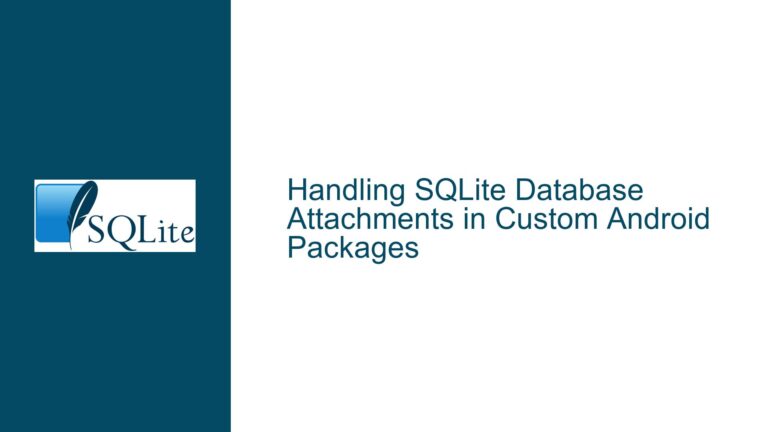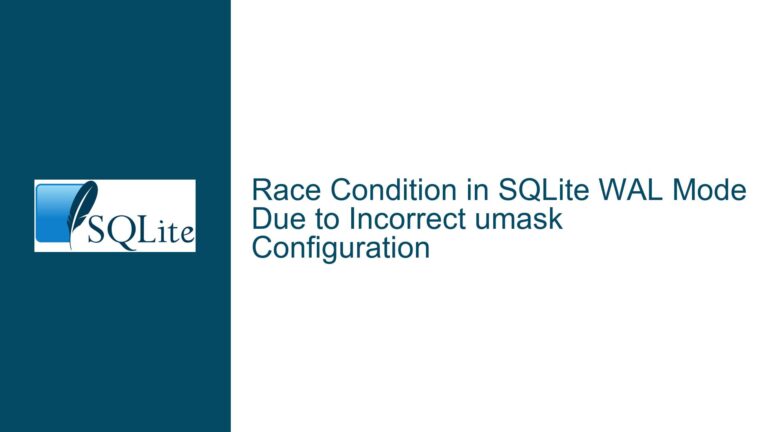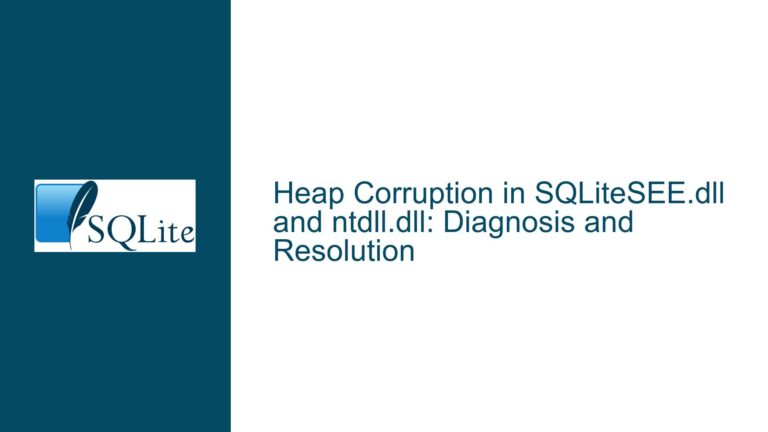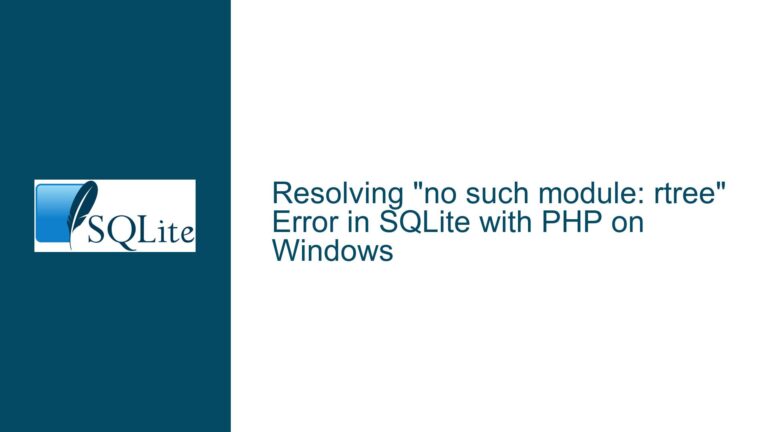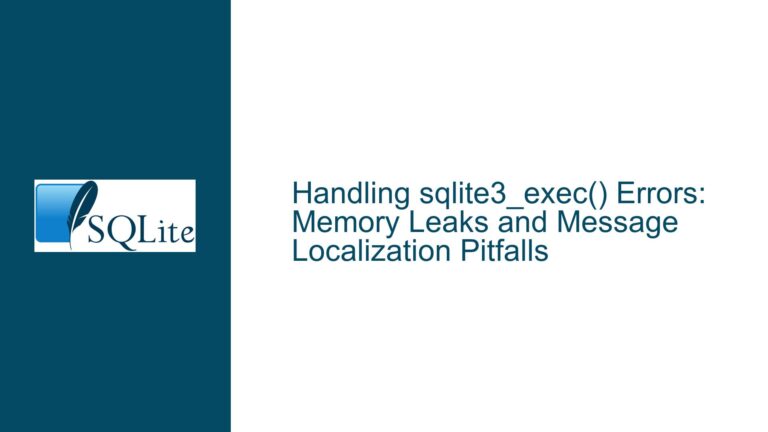Tracking Open SQLite Database Connections and Handles Programmatically
Understanding SQLite Connection Management and Database Handle Tracking
Core Challenge: Enumerating Active Database Handles and Associated Names
The central issue revolves around programmatically obtaining a list of all open SQLite database connections within an application, where each entry contains both the database identifier (name/path) and its corresponding connection handle. Users familiar with SQLite’s command-line interface (CLI) often encounter the PRAGMA database_list command or .databases directive, which displays attached databases with schema names like "main", "temp", or user-defined aliases. However, this output does not directly translate to the connection handles created via sqlite3_open() or similar API functions. The fundamental disconnect arises from three key SQLite architectural decisions:
- Connection Isolation: Each database connection exists as an independent entity represented by an opaque
sqlite3*handle. - No Global Registry: The SQLite library maintains no internal registry of active connections across a process.
- Attached vs. Connected: Databases attached to a connection (via
ATTACH DATABASE) remain subordinate to their parent connection handle rather than existing as independent connections.
This creates a scenario where developers must implement their own tracking mechanisms if they require a global view of all open database connections and their metadata. The absence of built-in enumeration functionality often surprises those accustomed to database systems with centralized connection pools or management APIs.
Architectural Constraints and Conceptual Misalignments
1. Opaque Handle Design Philosophy
SQLite connection handles (sqlite3*) are intentionally opaque to prevent applications from manipulating internal state directly. While this design enhances stability and encapsulation, it means:
- Handles lack intrinsic metadata like filenames or connection timestamps
- The library cannot reverse-map handles to their creation parameters (e.g., database path used in
sqlite3_open()) - Handle validity depends entirely on application-managed pointer integrity
2. Multi-Connection vs. Multi-Attach Confusion
Developers frequently conflate two distinct concepts:
- Independent Connections: Separate
sqlite3*handles created via multiplesqlite3_open()calls - Attached Databases: Schemas added to a single connection via
ATTACH 'file.db' AS alias
A connection handle manages all attached databases within its scope, but these do not constitute separate connections. This distinction critically impacts how databases are enumerated:
sqlite3* conn1;
sqlite3_open("main.db", &conn1); // Creates connection handle conn1
sqlite3_exec(conn1, "ATTACH 'aux.db' AS aux", 0, 0, 0); // Adds aux schema to conn1
sqlite3* conn2;
sqlite3_open("other.db", &conn2); // Creates entirely separate connection handle
Here, PRAGMA database_list executed on conn1 would list main and aux, while conn2 only lists main (pointing to other.db). Neither connection has awareness of the other’s existence.
3. CLI Behavior vs. Library Reality
The SQLite CLI’s .databases command provides an interactive view of attached databases for the current connection. This misleads developers into assuming equivalent functionality exists programmatically across all connections. In reality:
- CLI commands like
.openand.attachimplicitly manage a single active connection unless using newer multi-connection CLI features - The CLI’s ability to show attached databases stems from executing
PRAGMA database_liston its active connection – not from global connection tracking
4. Language Binding Abstractions
Higher-level language bindings (e.g., Python’s sqlite3 module, System.Data.SQLite in .NET) introduce additional abstraction layers that may:
- Implicitly cache/reuse connections
- Map connection handles to managed objects with finalizers/destructors
- Add proprietary extension methods for connection enumeration
These behaviors create environment-specific discrepancies where handle tracking logic must adapt to both SQLite’s C API and binding-specific peculiarities.
Implementation Strategies for Handle Tracking and Enumeration
1. Centralized Connection Factory Pattern
Intercept all connection creation points in your application to register handles in a global registry. This requires:
Step 1: Wrap SQLite Open Functions
Create wrapper functions that mirror sqlite3_open(), sqlite3_open_v2(), etc., but add tracking logic:
// Global registry (simplified example)
static std::map<sqlite3*, ConnectionInfo> connection_registry;
int tracked_sqlite3_open(const char* filename, sqlite3** ppDb) {
int rc = sqlite3_open(filename, ppDb);
if (rc == SQLITE_OK) {
connection_registry[*ppDb] = {
.filename = filename,
.open_time = std::chrono::system_clock::now()
};
}
return rc;
}
Step 2: Intercept Connection Closure
Override sqlite3_close() and sqlite3_close_v2() to remove entries from the registry:
int tracked_sqlite3_close(sqlite3* db) {
auto it = connection_registry.find(db);
if (it != connection_registry.end()) {
connection_registry.erase(it);
}
return sqlite3_close(db);
}
Step 3: Expose Registry via Accessor Function
Provide thread-safe read access to the connection registry:
std::vector<ConnectionInfo> get_open_connections() {
std::vector<ConnectionInfo> connections;
for (const auto& entry : connection_registry) {
connections.push_back(entry.second);
}
return connections;
}
Advantages:
- Complete control over connection lifecycle tracking
- Can enrich registry entries with application-specific metadata
- Works across all SQLite API usage within the application
Drawbacks:
- Requires modifying all connection open/close calls
- Thread safety complexity in multi-threaded environments
- May not track connections opened by third-party libraries
2. SQLite Hook Functions (Advanced)
Leverage SQLite’s configuration hooks to monitor connection activity:
Step 1: Install Connection Lifecycle Hooks
Use sqlite3_configure(SQLITE_CONFIG_HOOK, ...) to set up handlers for connection creation/destruction. Note that this approach is highly environment-dependent and may require custom SQLite builds.
Step 2: Utilize sqlite3_trace_v2() for Connection Detection
While not directly exposing connection creation, trace hooks can infer new connections by monitoring SQL execution contexts:
void trace_callback(unsigned mask, void* ctx, void* p, void* x) {
if (mask & SQLITE_TRACE_STMT) {
sqlite3* db = static_cast<sqlite3*>(ctx);
// Check if this connection is newly observed
if (!connection_registry.contains(db)) {
register_connection(db);
}
}
}
// During initialization:
sqlite3_trace_v2(nullptr, SQLITE_TRACE_STMT, trace_callback, nullptr);
Advantages:
- Potentially tracks connections created by any component in the process
- No need to modify existing open/close calls
Drawbacks:
- Relies on heuristic detection rather than definitive lifecycle events
- Performance overhead from tracing all SQL statements
- May miss connections that don’t execute traced statements
3. Foreign Key-Style Trigger Tracking (For Attached Databases)
While not solving connection handle tracking, this approach helps monitor databases attached to known connections:
Step 1: Automate Schema Registration on Attachment
Create a trigger that records attachment events in a global table:
-- In main database
CREATE TABLE attached_databases (
conn_id INTEGER, -- Application-generated connection identifier
schema_name TEXT,
file_path TEXT,
attach_time DATETIME
);
-- For each connection after creation:
SELECT APPLY_ATTACH_TRACKING(); -- Hypothetical function to install triggers
-- The trigger would fire after ATTACH commands:
CREATE TRIGGER track_attach AFTER ATTACH ON DATABASE BEGIN
INSERT INTO attached_databases VALUES(
get_application_conn_id(), -- Need to supply this via app
schema_name,
database_file,
CURRENT_TIMESTAMP
);
END;
Step 2: Correlate with Connection Handles
Combine this attachment log with your connection registry to map handles to their attached databases.
Advantages:
- Self-documenting within the database
- Survives application restarts if logged to persistent storage
Drawbacks:
- Only tracks explicit ATTACH operations
- Requires application cooperation to set up triggers
- Doesn’t help with base connection handles
4. Memory Analysis Techniques (Last Resort)
In extreme cases without source control, analyze process memory to locate sqlite3 structs:
Step 1: Scan Memory for SQLite Signature Patterns
The sqlite3 struct contains identifiable magic numbers like SQLite format 3\000. Memory scanning tools can search for these patterns.
Step 2: Reconstruct Handle Information
For each potential sqlite3 struct found:
- Extract filename from
sqlite3_filename(requires knowledge of struct layout) - Validate handle integrity through API calls like
sqlite3_db_readonly()
Advantages:
- Works without application cooperation
Drawbacks:
- Highly platform/version-dependent
- Risk of crashes from invalid pointer dereferencing
- Ethical/legal concerns in third-party processes
Best Practices and Mitigation Strategies
1. Encapsulate Database Access
Create a database access layer that:
- Proxies all SQLite API functions
- Automatically tracks connections and attached databases
- Enforces connection limits or pooling
2. Leverage ORM Capabilities
Use object-relational mappers (ORMs) that natively track connections:
# Python example with SQLAlchemy
from sqlalchemy import create_engine
from sqlalchemy.orm import scoped_session
engine = create_engine('sqlite://')
Session = scoped_session(sessionmaker(bind=engine))
# Track all active sessions
active_sessions = Session.registry.registry
3. Implement Connection Metadata Tables
For long-running applications, maintain a persistent registry:
CREATE TABLE _global_connection_metadata (
connection_uuid TEXT PRIMARY KEY,
open_time INTEGER,
filename TEXT,
application_context TEXT
);
Update this table through your connection factory whenever connections open/close.
4. Adopt Process Monitoring Tools
Use platform-specific tools to monitor SQLite file handles:
- Linux:
lsof -p PID | grep '\.db$' - Windows: Process Explorer filtering on *.db handles
- macOS:
dtracescripts trackingsqlite3_opencalls
5. Validate Handle Liveness Periodically
Implement background threads that periodically verify connection validity:
void connection_watchdog() {
while (true) {
std::this_thread::sleep_for(std::chrono::minutes(1));
for (auto& [handle, info] : connection_registry) {
int rc = sqlite3_exec(handle, "SELECT 1", nullptr, nullptr, nullptr);
if (rc != SQLITE_OK) {
handle_zombie_connection(handle);
}
}
}
}
Debugging Checklist for Connection Leaks
Audit All Connection Open/Close Calls
- Ensure every
sqlite3_openhas a matchingsqlite3_close - Use static analysis tools to detect unbalanced calls
- Ensure every
Profile Handle Count Over Time
- Log connection registry size at intervals
- Graph handle count vs. application actions
Analyze Attachment Proliferation
- Run
PRAGMA database_liston long-lived connections - Detect unattached databases via:
SELECT * FROM aux.sqlite_master; -- Error indicates missing attachment
- Run
Stress Test with Connection Limits
- Enforce artificial connection caps during testing
- Use
ulimitor equivalent to restrict file handles
Inspect Finalization in Garbage-Collected Languages
- Verify that connection objects aren’t being prematurely collected
- Check for missing
close()calls in exception handlers
By internalizing SQLite’s connection model and implementing robust tracking infrastructure, developers can achieve the desired database handle visibility while respecting the library’s design constraints. The key insight is recognizing that connection management responsibility resides with the application layer rather than the SQLite library itself.
